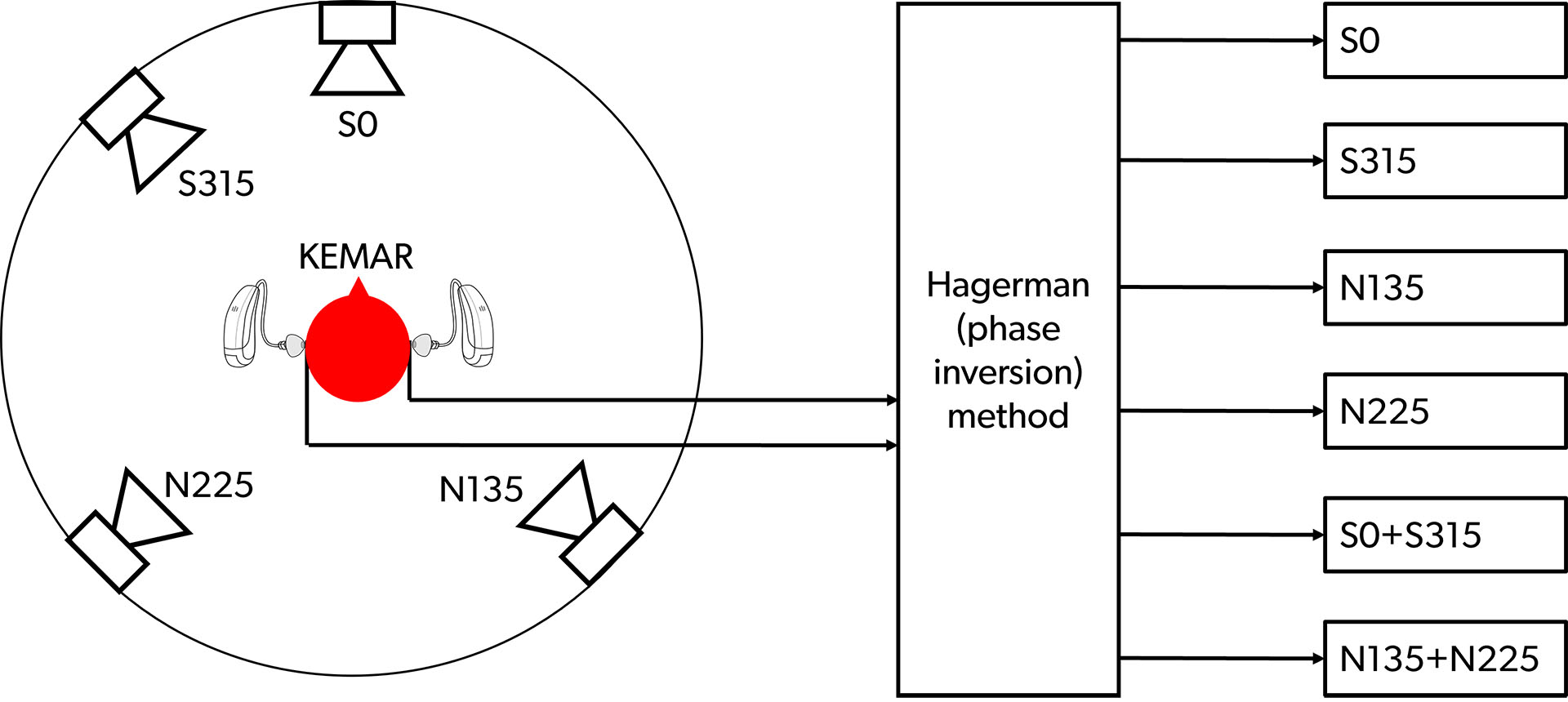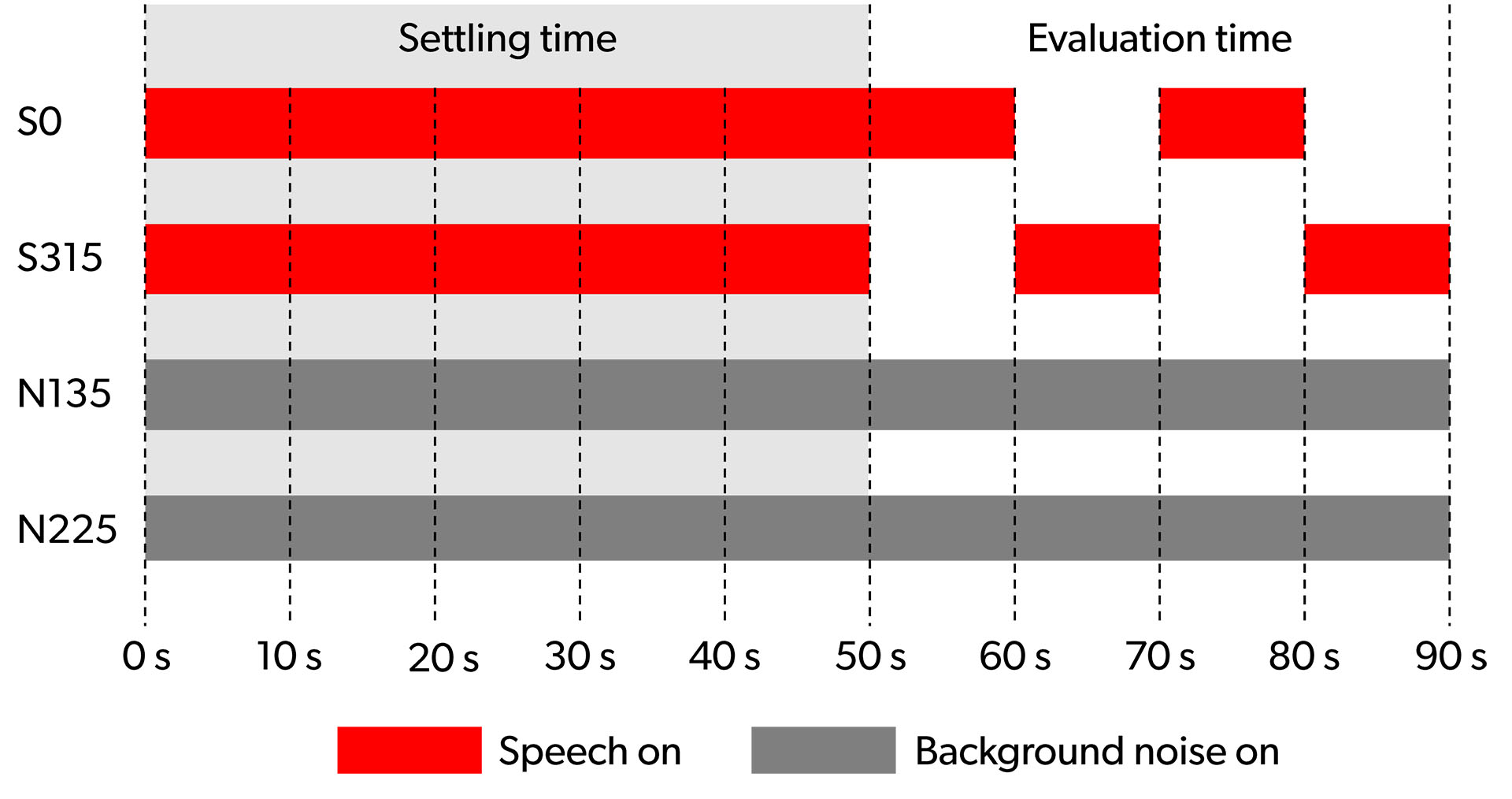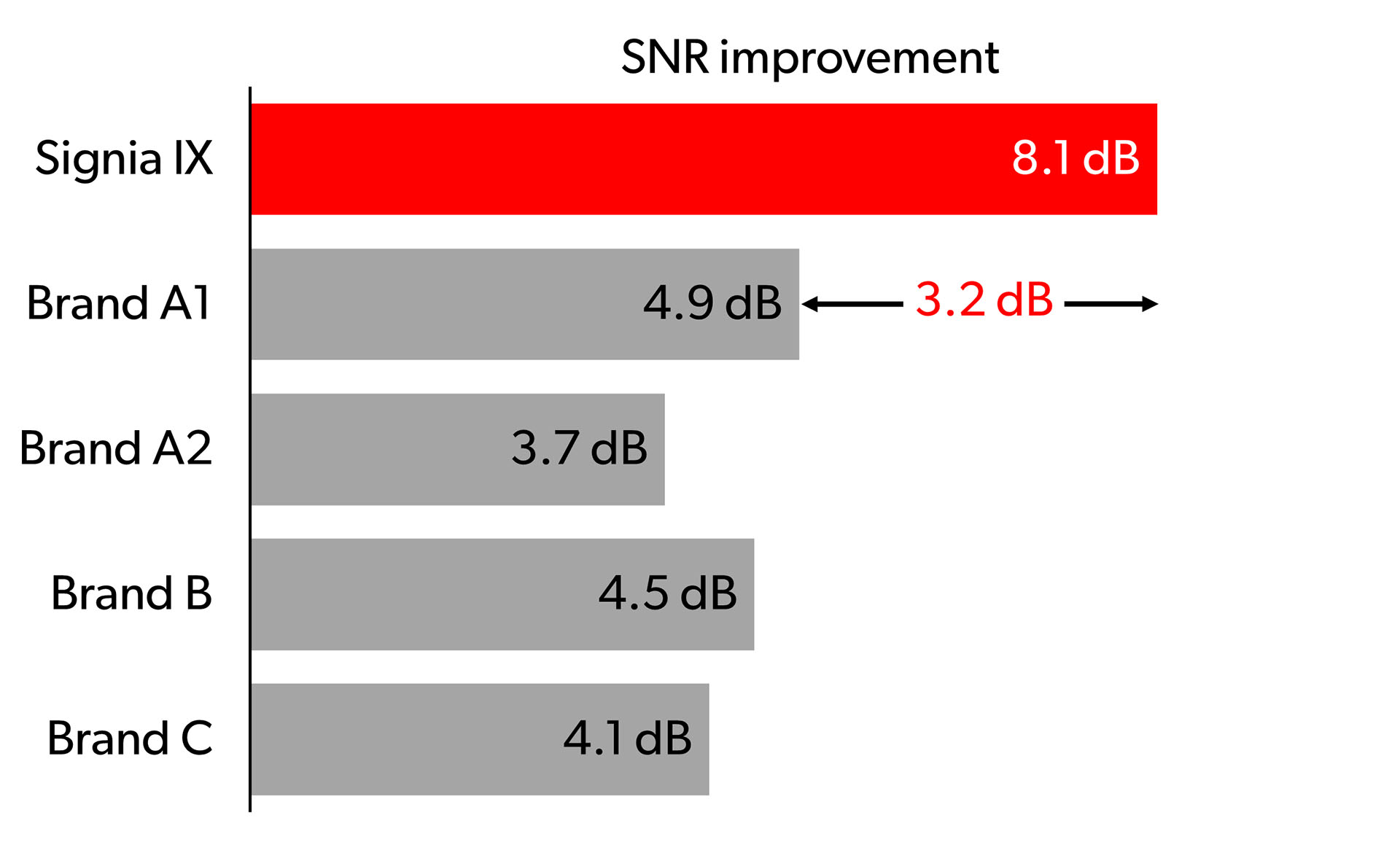Signia IX delivers more than twice the speech enhancement benefit in a noisy group conversation than the closest competitors
Niels Søgaard Jensen, Cecil Wilson, Homayoun Kamkar Parsi, Barinder Samra, Jens Hain, Sebastian Best, Brian Taylor
Signia Integrated Xperience (IX) introduced RealTime Conversion Enhancement technology to help wearers participate and engage in noisy group conversations. Supported by an advanced sound scene analysis and a unique multi-stream architecture, Signia IX wearers can follow and contribute to conversations in all dynamic and challenging situations. In this paper, we update a previous study to include the latest 2024 releases from key competitors in a technical comparison of Signia IX and top 4 competitor hearing aids in a simulated dynamic group conversation in loud background noise. A clear 3.2 dB signal-to-noise ratio advantage for Signia IX was observed. This means that Signia IX delivers more than twice the speech enhancement benefit in a noisy group conversation than the closest competitors, including AI co-processor-driven platforms.
Take-away messages
- This study is designed to reflect dynamic situations wearers face in real life, testing how hearing aids perform in the most challenging scenarios.
- In a dynamic group conversation in background noise, Signia IX provides an 8.1 dB improvement in signal-to- noise ratio (SNR) compared to unaided listening, and Signia IX outperforms the competition with a 3.2 dB higher SNR than the very best of top 4 competitor hearing aids.
- Signia IX delivers more than twice the speech enhancement benefit in a noisy group conversation than the closest competitors, including AI co-processor- driven platforms.
- The SNR boost is expected to enhance speech understanding, enabling Signia IX wearers to contribute actively in even the busiest of conversations.
- Signia IX’s superior speech enhancement is powered by advanced split and multi-stream processing, allowing the IX platform to independently enhance speech and process noise, unlike competitor systems that can only process them together in a single stream.
- If your client has issues hearing in busy conversations in noise, Signia IX is proven to be best at capturing speech in a dynamic conversation.
Introduction
A reduced ability to understand other people speaking in noise is known to be one of the most noticeable and important consequences of hearing loss. Providing the ability to understand speech in noise – and thereby to allow participation in conversations in background noise – is therefore one of the most important tasks for a hearing aid. In a survey of almost 15,000 people, with the vast majority having a self-reported hearing loss, “hearing friends and family in noise” was found to be the most desirable hearing aid attribute, with 88.3% of respondents rating this attribute to be very or extremely important (Manchaiah et al., 2021).
With every new generation of Signia speech enhancement and noise reduction technologies, there has been a renewed focus on balancing improved speech understanding in noise with awareness of sound in the wearer’s surroundings.
With our latest innovation, Signia Integrated Xperience (IX) with RealTime Conversation Enhancement (RTCE), Signia has taken a major leap forward. Rather than simply improving speech understanding ability in a static acoustic scene in which the talker of interest is facing the hearing aid wearer, advancements in real- time analysis and processing of conversation scenarios now improve the entire wearer experience in dynamic group conversations in background noise. The scene analysis and the combined effect of the unique split processing – that allows separate processing of speech and noise – and the new multi-stream processing approach of RTCE provides the wearer the ability to fully participate in and contribute to the conversation, while being fully immersed in the surroundings. For a more detailed description of split processing and RTCE, see Jensen et al. (2021) and Jensen et al. (2023a), respectively.
The clinical performance of – and benefits provided by – Signia IX with RTCE have already been demonstrated in a wide variety of studies. The unique multi-stream architecture of Signia IX requires studies with multiple dynamic talkers to fully showcase its capabilities. We believe these test setups are crucial for advancing the industry beyond simple comparisons with static single speakers in noise. Our goal is to promote test methodologies that are either conducted in real- world environments or designed to better reflect the conversational realities of our wearers.
Among the Signia IX studies, we will mention a few recent highlights. Researchers at the University of Western Ontario tested the effect of RTCE in a real- world noisy group conversation scenario in a busy food court. They found high levels of listening satisfaction and a significant preference for RTCE in real-world conversations (Folkeard et al., 2024). Researchers at ORCA-USA, using a dynamic multi-talker setup, have published results from a human performance study showing improved speech understanding, more noise tolerance and reduced self-reported listening effort with RTCE (Korhonen & Slugocki, 2024). The researchers also conducted objective EEG measurements that suggested that RTCE reduces listening effort (Slugocki et al., 2024).
A technical evaluation has previously been conducted in a dynamic multi-talker scenario (Jensen et al., 2023b). That study investigated the increase in signal- to-noise ratio (SNR) – i.e., the ability of the hearing aid to enhance the speech above noise – provided by Signia IX and four key competitors in a dynamic group conversation in noise. Improving the signal-to-noise ratio (SNR) is obviously one of the most important prerequisites for improving speech understanding in noise. In this comparison, Signia IX provided an SNR that was 3.2 dB higher than the best of the competitors. This substantial difference can be explained by the split processing and multi-stream processing philosophies applied in Signia IX hearing aids, whereby speech is processed and enhanced independently of noise reduction, and multiple binaural beams continuously adapt to the conversation setting. In contrast, the competitor hearing aids used traditional single-stream processing, where noise reduction can affect speech clarity since speech and noise are processed together.
Since the completion of that SNR study, some key competitors have launched new products featuring technologies like Deep Neural Network (DNN)-based noise reduction. However, these products still rely on the same fundamental single-stream processing, which may limit their ability to independently manage speech and noise.
While competitors have published data highlighting the benefits of their new products, they have not tested them in a dynamic, multi-talker environment that mirrors real-life conversations. To see how the competitor hearing aids compare to Signia IX in a scenario reflecting a busy group conversation, we updated our original study to include these newer products.
Why group conversation testing is key
Hearing aid wearers report the lowest listening satisfaction in noisy group conversations (Picou, 2022), with the ability to listen easily being key to success, alongside the ability to actively contribute (Nicoras et al., 2023). Background noise, alternating talkers, and the movement of the wearer’s head create significant challenges in these situations. Signia IX was specifically built and tested to meet these challenges, and wearer surveys show its effectiveness in real- world group conversations (Jensen et al., 2024).
Methods
The investigation aimed to assess the SNR performance of the different hearing aids in a dynamic conversation scenario with multiple speakers taking turns, as opposed to a more static setup with just one talker in the front.
Hagerman method
The investigation was based on the widely recognized Hagerman phase-inversion technique originally proposed by Hagerman & Olofsson (2004). This method offers a way to assess noise reduction systems in hearing aids when speech and noise are present at the same time. By recording the combined signal (speech and noise) on the output side of the hearing aid, with and without phase inversion of the input signals, the methodology makes it possible to isolate the processed speech and the processed noise. By averaging across the speech and noise signals, respectively, it is possible to provide a precise estimate of the output SNR experienced by the hearing aid wearer.
Measurement setup
The measurement setup, shown in Figure 1, was established in a sound treated room and included a KEMAR manikin (in the center of the setup) and four loudspeakers positioned at a distance of 1 m. Sections of the International Speech Test Signal (ISTS) (Holube et al., 2010) were presented from two loudspeakers at 0° and 315° at a level of around 76 dBA, while a background noise consisting of a recording made in a busy cafeteria mixed with pink noise was presented from two loudspeakers at 135° and 225° at a total level of around 72 dBA. This yielded a ‘starting point’ SNR of +4 dB for the test environment.
To determine the output SNR, the hearing aids were positioned in the KEMAR ears, and a series of recordings were made with and without phase inversion of the different input signals. Applying the phase-inversion technique on the recordings then allowed estimation of each of the processed signals at the output of the hearing aids, both for the individual speech and noise sources, and for the combined speech and noise, as illustrated in Figure 1.

FIGURE 1
Setup used for output SNR measurements. Speech (S) signals were presented from the two loudspeakers in the front hemisphere, and noise (N) signals were presented from the two loudspeakers in the back hemisphere. The signals processed by the hearing aids were recorded in the KEMAR ears, with and without phase inversion of each signal, and the Hagerman method was used to generate estimates of the various S and N signals, both alone and in combination.
In the measurements, the sound signals from the four loudspeakers were presented as shown in Figure 2.

FIGURE 2
Presentation of signals from the four loudspeakers. The signal presentation started at t=0, while recordings used for the analysis were started at t=50 seconds to allow enough time for the hearing aids to reach a stable working condition. The analysis was based on 40 seconds of recordings (evaluation time), including two sections of 10 seconds from each of the two talker locations (S0 and S315).
The conversation scenario was established by alternating between S0 and S315, with the signal being presented from a given direction for 10 seconds before switching, as indicated in Figure 2. Each recording included two sections with S0 and two sections with S315, for a total of 40 seconds. Prior to the recording, the sound signals were on for 50 seconds to allow all the hearing aids to settle.
The outcome of the analysis is the output SNR of the different hearing aids, averaged across the evaluation time. Due to the test layout where speech was presented from the front and from the left side of the KEMAR, we present the output SNRs of the left hearing aid, which is most relevant to speech understanding due to the better ear effect. In the analysis, we calculated the overall conversation SNR, (S0+S315)/ (N135+N225).
Hearing aids
In the previous SNR study (Jensen et al., 2023b), the performance of Signia Pure Charge&Go IX was compared to the performance of premium receiver- in-canal (RIC) hearing aids from top 4 competitors. However, one of the competitor hearing aids performed worse than the baseline unaided condition, and since the manufacturer has not launched a replacement product, we excluded it from this updated study for simplification of the results.
The participating competitor hearing aids are labeled Brand A-C. At the time of the measurement, each hearing aid represented the most current premium RIC hearing aid offered by each respective manufacturer. For the measurements, Signia IX and all competitor hearing aids were programmed to a symmetrical, flat 50 dB hearing loss, using the default setting prescribed by each manufacturer’s recommended (proprietary) fitting rationale. All hearing aids were tested in the default setting of their respective Universal program. To ensure valid application of the phase-inversion technique, features manipulating the signal phase (feedback cancellation and frequency compression) were deactivated in all the hearing aids. The hearing aids were fitted to the KEMAR’s ears using closed coupling eartips.
To investigate the effect of the DNN noise reduction applied on the AI co-processor-driven platform offered by Brand A, an additional measurement was also done with the Brand A hearing aids in a manual program where the DNN noise reduction was turned off. The two test settings will be referred to as Brand A1 and Brand A2, respectively.
As baseline, recordings were also made in the open (unaided) KEMAR ears. This allowed the open ear SNR to be calculated and used as a reference, representing the input SNR.
Results
The conversation SNRs measured for each hearing aid are presented relative to the unaided SNR measured in the open KEMAR ear. Thus, the results shown in Figure 3 are the relative SNR improvements for each hearing aid. The figure shows the SNR improvements, measured across the two talker positions, for Signia IX and the three key competitor hearing aids, which were included in the investigation. As mentioned above, two Brand A measurements were performed, one with DNN noise reduction enabled (A1), and one with the feature deactivated (A2).

FIGURE 3
Conversation SNR improvement, relative to the unaided condition, measured across the two talker locations, for Signia IX and the three competitor hearing aids (Brand A-C). All hearing aids were measured in their default Universal settings, except for Brand A2 which was measured in a manual program with the DNN noise reduction turned off.
Figure 3 shows that all four hearing aids offered an SNR benefit, as illustrated by the positive improvement values. Signia IX clearly offered the largest benefit.
The conversation SNR improvement provided by Signia IX, compared to the unaided condition, was 8.1 dB, while the best competitor hearing aid (Brand A1) offered an SNR improvement of 4.9 dB. That is, in this conversation scenario, Signia IX offered an improvement in output SNR of a staggering 3.2 dB, compared to the best-performing competitor.
The three competitor hearing aids were quite similar to each other in their Universal program performance, with improvements being within 1 dB of each other (4.1 dB to 4.9 dB). For the Brand A hearing aid, the measurement with the DNN noise reduction enabled (A1) showed an improvement (4.9 dB), which was 1.2. dB higher than the improvement (3.7 dB) observed in the measurement with the function deactivated (A2). This effect is consistent with data published by the manufacturer.
Discussion
In this study, we investigated the output SNR performance of Signia IX and three competitor hearing aids in a simulated group conversation scenario with two conversation partners in the front hemisphere and with continuous noise coming from the back hemisphere. The results showed Signia IX outperformed all three competitors, offering an overall conversation SNR benefit of 8.1 dB compared to unaided listening and 3.2 dB compared to the best competitor.
A 3 dB increase in SNR corresponds to a doubling of the ratio between the intensity of the speech and the intensity of the noise. Thus, the observed 3.2 dB advantage on the output of the hearing aid means that Signia IX delivers more than twice the speech enhancement benefit in the noisy group conversation scenario than the best-performing competitor.
When comparing data from this SNR study to the data from the previous similar study (Jensen et al., 2023b), we observe the same performance of Signia IX in the two studies. This was obviously expected, since the split processing and RTCE remain the same. Looking at the competitors, while we observe that their new products have modest improvements in their SNR performance of up to 1.5 dB, compared to their previous models, the Signia IX performance in the dynamic group conversation is still superior.
We conclude that the significant difference observed between Signia IX and the other premium competitor hearing aids is primarily a result of IX’s split processing and RTCE technology. First, IX’s core ‘always-on’ split processing reduces noise separately to enhance speech. Second, RTCE provides advanced analysis of the conversation layout of the talkers, continuously pinpointing and adapting to conversation partners and noise sources in real time.
In the test setup, the Signia IX hearing aids always recognize whether speech is coming from the front or side of the wearer, allowing RTCE’s multi-stream architecture to tailor each stream’s processing accordingly. This creates a dynamic auditory space where active talkers are enhanced, while extraneous environmental sounds are processed independently. RTCE adapts seamlessly to changes in the conversation, such as turn-taking, which was simulated in our study by alternating speech from the front and side of the KEMAR manikin.
Finally, this study highlights RTCE’s ability to allow wearers to engage in conversation without always facing the active talker. Since the stationary KEMAR head faces forward while speech alternates between the front and side, the hearing aid processing must adapt to the speech location in real time. Ultimately, this will facilitate a more natural conversational behavior in the real world where the wearer can easily follow the flow of the conversation. The ability to independently enhance speech and quickly adapt to transitions between talkers, enabled by RTCE’s multi-stream architecture, is likely a key factor in the SNR benefits provided by Signia IX in comparison to the competitor hearing aids. Traditional hearing aids (and all competitors in this study) use single-stream processing where speech and noise are treated the same way. While these systems may apply some form of adaptive processing when conversation partners take turns, they often respond too slowly to keep up with rapid changes like those implemented in this test. In real-world conversations, where speakers taking turns every 10 seconds in a conversation is quite realistic, this slow adaptation may limit the effectiveness of these systems.
When listening to speech in noisy environments, there is a strong link between the SNR of the listening situation, the clarity of the talkers, and the listener’s ability to understand speech. Improving the output SNR of a hearing aid generally enhances speech understanding in challenging situations with background noise. However, this relationship is not straightforward and depends heavily on the listening conditions and the SNR. In this study, we focused on measuring the output SNR under well-defined yet realistic conditions to ensure a meaningful and ecologically valid comparison of the hearing aids. We selected a test SNR of around +4 dB – very close to the +4.6 dB median SNR for speech in babble reported by Smeds et al. (2015) – to replicate the kinds of real-life situations where hearing aid wearers start to struggle with speech understanding. Consequently, this SNR was chosen because it most closely reflects real-world conditions where the hearing aid’s impact matters most to the wearer. This supports our goal of only testing hearing aids in conditions that truly matter for wearers in everyday life.
Summary
In this paper, we have presented the results of a technical study on the SNR performance provided by Signia Integrated Xperience and three competitor hearing aids. A technical assessment was performed in an acoustic scene simulating a group conversation scenario in background noise with two conversation partners located in front of and to the side of the hearing aid wearer. The assessment was based on the widely used Hagerman phase-inversion technique, allowing estimation of the output SNR provided by the hearing aids in the given setup.
Our analysis demonstrates a clear SNR performance advantage for Signia Integrated Xperience with RealTime Conversation Enhancement. Signia IX provided an 8.1 dB SNR benefit relative to the unaided condition, and a 3.2 dB SNR improvement relative to the best- performing competitor hearing aids.
This means that Signia IX delivers more than twice the speech enhancement benefit in a noisy group conversation than the closest competitors, including AI co-processor-driven platforms.
Since improvements in the output SNR can be linked to improvements in speech understanding if the wearer is in a noisy group conversation situation where they struggle to participate, the results of this study suggest that Signia IX could potentially offer a strong benefit in such situations, making it easier for the wearer to participate in and contribute to the conversation.
References
Folkeard P., Jensen N.S., Parsi H.K., Bilert S. & Scollie S. 2024. Hearing at the Mall: Multibeam Processing Technology Improves Hearing Group Conversations in a Real-World Food Court Environment. Am J Audiol, 33, 782-792.
Hagerman B. & Olofsson Å. 2004. A method to measure the effect of noise reduction algorithms using simultaneous speech and noise. Acta Acustica United with Acustica, 90(2), 356-361.
Holube I., Fredelake S., Vlaming M. & Kollmeier B. 2010. Development and analysis of an international speech test signal (ISTS). International Journal of Audiology, 49(12), 891-903.
Jensen N.S., Høydal E.H., Branda E. & Weber J. 2021. Improving speech understanding with Signia AX and Augmented Focus. Signia White Paper. Retrieved from www.signia-library.com.
Jensen N.S., Samra B., Kamkar Parsi H., Bilert S. & Taylor B. 2023a. Power the conversation with Signia Integrated Xperience and RealTime Conversation Enhancement. Signia White Paper. Retrieved from www.signia-library.com.
Jensen N.S., Samra B., Taghvaei N. & Taylor B. 2024. Improving the Real-World Conversation Experience With a Multi-Stream Architecture. Hearing Review, 31(9), 16-20.
Jensen N.S., Wilson C., Kamkar Parsi H. & Taylor B. 2023b. Improving the signal-to-noise ratio in group conversations with Signia Integrated Xperience and RealTime Conversation Enhancement. Signia White Paper. Retrieved from www.signia-library.com.
Korhonen P. & Slugocki C. 2024. Augmenting Split Processing with a Multi-Stream Architecture Algorithm. Hearing Review, 31(5), 20-23.
Manchaiah V., Picou E.M., Bailey A. & Rodrigo H. 2021. Consumer Ratings of the Most Desirable Hearing Aid Attributes. Journal of the American Academy of Audiology, 32(8), 537-546.
Nicoras R., Gotowiec S., Hadley L.V., Smeds K. & Naylor G. 2023. Conversation success in one-to-one and group conversation: a group concept mapping study of adults with normal and impaired hearing. International Journal of Audiology, 62(9), 868-876.
Picou E.M. 2022. Hearing aid benefit and satisfaction results from the MarkeTrak 2022 survey: Importance of features and hearing care professionals. Seminars in Hearing, 43(4), 301-316.
Slugocki C., Kuk F. & Korhonen P. 2024. Using Alpha-Band Power to Evaluate Hearing Aid Directionality Based on Multistream Architecture. Am J Audiol, Early Online, 1-12.










